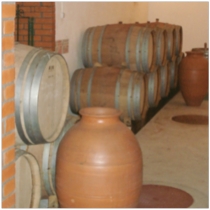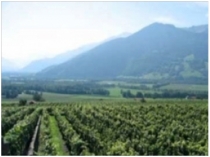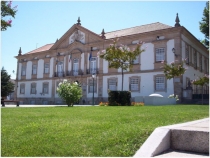Terras da Beira
Wine region: TERRAS DA BEIRA
The Beira Interior DO has been included within the region currently designated as Terras da Beira (since 2 November 1999). The areas making up the Beira Interior are part of a much broader vitivinicultural region designated as IG Beiras. Terras da Beira was the capital of the Lusitanian people, where their King Viriathus was assassinated in AD 139 by the Romans who subsequently took possession of this land. Around six hundred years later saw the emergence of the Visigoths. Both they and the Romans had strong links with viticulture. The Cistercian monks began revitalising viticulture in the 12th century after the Reconquista. The Muslim Arabs were less interested in the cultivation of the vine. Situated in the northern interior close to the Spanish border, in the most rugged and steeply mountainous region of mainland Portugal, the region covers the Serra da Marofa, the Serra da Gardunha and part of the Serra de Estrela mountain ranges.
In terms of the Beira Interior DO, the Beira Interior subregions of Castelo Rodrigo, Pinhel and Cova de Beira have always been noted for wines of high oenological value, which convey an aroma richer and more distinct than that of wine from other regions. The high altitude of the vineyards, above 400 m and located as high as 700 m, covering a total of 16,000 hectares, is reminiscent of Portugal’s neighbouring country with its great vitivinicultural regions within the greater region of Castile and Leon. The evenings are cool in the summer, and even cold during the time of harvest and fermentation. Even before the advent of modern technologies of controlled fermentation, these temperatures made it possible to produce fresh and aromatic mature wines. During its period of great exports in the mid‑20th century, especially to the United State of America and the north of Europe, the rosé wine was always considered the best and brought some prosperity to this region.
Detailed edapho‑climatic information on the region can be found on the website of the COMISSÃO VITIVINÍCOLA REGIONAL DA BEIRA INTERIOR (“REGIONAL VITIVINICULTURAL COMMISSION OF THE BEIRA INTERIOR”), abbreviated to CVRBI, which is the officially approved certification authority for DO and IG products of the region. The climate suffers from extreme mainland influences, including considerable variations in daily temperature. The summers are very short, but extremely hot and dry, while the winters are long and very cold. The soils are for the most part granitic, with some schist, and sometimes, although it is less common, have a sandy component. The three sub‑regions share much the same material characteristics, despite being separated by mountain ranges with peaks of over a thousand metres in altitude, where the combination of poor soils, high acidity and robust maturation ensures a promising future for the region. The Cova da Beira has a number of different features, spreading as it does from the eastern foothills of the Serra da Estrela to the Tagus valley, south of Castelo Branco. The cooperative cellars produce most of the region’s wine although, increasingly, wines from small‑ and medium‑sized producers are appearing on the market. The north of the Beiras region, which borders on the Douro region, is located in the Távora‑Varosa Designation of Origin area. It is a small region, but nevertheless a very important producer of sparkling wines which have the upper hand over other types of wine, although fresh white wines and suave reds are also produced.
Wine types typical of the region
Terras da Beira IG wine or Terras da Beira regional wine: Red, white, rosé, sparkling, semi‑sparkling.
Beira Interior DO wine (VQPRD): Red, red “Palhete”, red “Selecção”, white, white “Selecção”, rosé.
Beira Interior sparkling wines (VEQPRD): Red, white, rosé
Regional Contacts
Technical information: Certification authority: COMISSÃO VITIVINÍCOLA REGIONAL OF THE BEIRA INTERIOR (“REGIONAL VITIVINICULTURAL COMMISSION OF THE BEIRA INTERIOR”) Av. Cidade de Safed, Lt. 7 – 1.º, 6300‑537 GUARDA, Tel.: 271 224 129, Fax: 271 223 101; e‑mail: cvrbi@cvrbi.artelecom.pt, Website: www.cvrbi.pt
Cultural information on the wine of the region: Sala Museu de Vinho (Wine Museum), 6200‑165 Covilhã – Quinta das Poldras
Institutions of higher learning
Escola Superior Agrária do Instituto Politécnico de Castelo Branco. (“Agricultural College of the Castelo Branco Polytechnic Institute”) Quinta da Senhora de Mércules 6000 Castelo Branco Tel.: 272 339 900, Website: www.ipcb.pt
Certification authority: COMISSÃO VITIVINÍCOLA REGIONAL OF THE BEIRA INTERIOR (“REGIONAL VITIVINICULTURAL COMMISSION OF THE BEIRA INTERIOR”) 6300‑537 GUARDA , Av. Cidade de Safed – Lote 7 – 1.º, Tel.: 271 224 129, Fax: 271 223 101 Website: www.cvrbi.pt, e‑mail: cvrbi@cvrbi.artelecom.pt
Eno‑tourism information: The Beira Interior Wine Route, rua cidade de Safed, lote 7 – 1º, 6300‑537 Guarda, Tel.: 271224129, Website: www.cvrbi.pt.

Producer and bottler information on wine from Terras da Beira: http://www.ivv.min‑agricultura.pt/np4/1736.html, → IVV Yearbook 2010/2011, page 182.
Designation: IGP “Terras da Beira”

Legislation: Ministerial Directive No. 163/2011 dated 18 April, Decree‑Law No. 212/2004 dated 23 August and Council Regulation (EC) No. 1234/2007 dated 22 October, as amended by Council Regulation (EC) No. 491/2009 dated 25 May.
Varieties
RED WINES:Água Santa, Alfrocheiro, Alicante Bouschet, Alvarelhão, Aragonez (Tinta Roriz), Azal, Baga, Bastardo, Cabernet Franc, Cabernet Sauvignon, Camarate, Campanário, Castelão, Cidreiro, Coração de Galo, Cornifesto, Grand Noir, Jaen, Malvasia Preta, Marufo, Merlot, Monvedro, Moreto, Pilongo, Pinot Noir, Português Azul, Rabo de Ovelha Tinto, Rufete, Sirah, Tinta Carvalha, Tinta Francisca, Tintem, Tinto Cão, Touriga Fêmea, Touriga Franca, Touriga Nacional, Trincadeira, (Tinta Amarela), Alvar Roxo, Folgazão Roxo, Gewurztraminer and Malvasia Fina Roxa.
WHITE WINES:Alicante Branco, Alvar, Arinto (Pedernã), Arinto do Interior, Assaraky, Barcelo, Bical, Cercial, Chardonnay, Dona Branca, Encruzado, Fernão Pires (Maria Gomes), Folgasão, Folha de Figueira, Fonte Cal, Gouveio, Jampal, Loureiro, Luzidio, Malvasia Fina, Malvasia Rei, Pinot Blanc, Rabo de Ovelha, Riesling, Sauvignon, Semillon, Sercial (Esgana Cão), Sercialinho, Síria (Roupeiro), Tália, Tamarez, Terrantez, Uva Cão, Verdelho, Verdial Branco and Vital.
Designation: DOP Beira Interior VQPRD

Decree‑Law No. 212/2004 dated 23 August, Decree‑Law No. 165/2005 dated 11 February and Reg. (EC) No. 1493/99 dated 17 May.
The DOP subregions are: Pinhel, Castelo Rodrigo, Cova da Beira
Varieties:
RED WINES: Aragonez (Tinta Roriz),** Bastardo,** Rufete,** Touriga Nacional** and Trincadeira (Tinta Amarela),** together, or separately, with at least 80% content of the specified grape variety or varieties, Alfrocheiro, Alicante Bouchet, Baga, Cabernet Sauvignon, Caladoc, Camarate, Castelão (Periquita), Grand Noir, Jaen, Marufo, Merlot, Mourisco, Petit Bouschet, Petit Verdot, Pinot Noir, Rabo de Ovelha Tinto, Syrah, Tinta Barroca, Tinta Carvalha, Tinto Cão and Touriga Franca.
WHITE WINES: Arinto,** Bical,** Malvasia Fina,** Síria (Roupeiro)** and Tamarez,** together, or separately, with at least 80% content of the specified grape variety or varieties, Alicante Branco, Arinto do Interior, Cercial, Chardonnay, Encruzado, Fernão Pires, Folgasão, Folha de Figueira, Fonte Cal, Gouveio, Malvasia Rei, Riesling, Sauvignon and Semillon.
(** Varieties which may be used when blending VQPRD white “Selecção” and VQPRD red “Selecção”)






